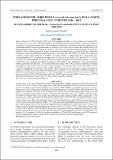Por favor, use este identificador para citar o enlazar este ítem:
https://hdl.handle.net/20.500.12958/3603Registro completo de metadatos
| Campo DC | Valor | Lengua/Idioma |
|---|---|---|
| dc.contributor.author | Aguilar-Arakaki, Regina | - |
| dc.date.accessioned | 2021-10-19T19:09:37Z | - |
| dc.date.available | 2021-10-19T19:09:37Z | - |
| dc.date.issued | 2021-07 | - |
| dc.identifier.citation | Aguilar-Arakaki R. 2021. Población del lobo fino Arctocephalus australis en la costa peruana en el periodo 2016-2019. Bol Inst Mar Perú. 36(1): 188-204 | es_ES |
| dc.identifier.issn | 04587766 | - |
| dc.identifier.uri | https://hdl.handle.net/20.500.12958/3603 | - |
| dc.description.abstract | El objetivo fue describir el estado poblacional del lobo fino Arctocephalus australis en la costa peruana entre 2016 y 2019, mediante estimación de parámetros como éxito reproductivo y variabilidad anual. Los censos poblacionales se realizaron por conteo directo en las loberías del litoral, en la temporada reproductiva de la especie (noviembre – diciembre). La población mínima estimada en promedio fue 8475,3 ± 861,9 individuos (n=4). La mayor concentración se presentó en la zona sur (~91,9% de la población registrada), siendo las localidades más importantes: Punta San Juan (15°21’46’’S, 75°11’36’’O) en Marcona (~37,8%) y Punta Coles (17°42’10’’ S, 71°22’51’’ O) en Ilo (~24,2%). La abundancia de la zona centro (11°-14°S) representó el ~7,7% de individuos registrados en 2016-2019. La colonia de isla Foca (5°12’S – 81°12’S) en Piura es la única localidad de la zona norte. Las categorías más abundantes fueron hembras y juveniles (~62,5%); las crías representaron ~20,5%, los machos, tanto adultos como subadultos, ~7,5%. La producción estimada promedio de crías fue 1736 ± 363,8 individuos (rango: 768, n=4). La mayor cantidad de colonias reproductivas se encontró entre 15°S y 17°S, Punta San Juan tuvo mayor producción de crías (~887,3 ± 181,2) (~51,37%), seguida de Punta Coles (~429,8 ± 141,3; ~24,6%); lo cual es relevante para la conservación de esta especie y el manejo de las actividades pesqueras que se realizan en estas zonas. En el periodo evaluado, la población mostró tendencia decreciente; en el 2019 la población fue menor en 20,1% con respecto al 2016, fue más acentuada en 17°S (en 2019 la disminución fue de 28,3% con respecto a 2016), mientras que en 15°S la disminución fue 22,5%, y en 16°S fue 7,6% para el mismo periodo evaluado | es_ES |
| dc.description.abstract | ABSTRACT: This paper aims to describe the population status of the South American fur seal (Arctocephalus australis) along the Peruvian coast from 2016 to 2019, by estimating parameters such as reproductive success and annual variability. The mean population was 8475.3 ± 861.9 individuals (n=4). The highest concentration occurred in the southern area (~91.9% of the recorded population), with the most important localities being: Punta San Juan (15°21’46’’S, 75°11’36’’W) in Marcona (~37.8%) and Punta Coles (17°42’10’’ S, 71°22’51’’ W) in Ilo (~24.2%). The abundance of the central area (11°-14°S) accounted for ~7.7% of individuals recorded in 2016-2019. The colony of Foca Island (5°12’S - 81°12’S) in Piura is the only locality in the northern zone. The most abundant categories were females and juveniles (~62.5%); pups accounted for ~20.5%, males, both adults and sub-adults, ~7.5%. The mean estimated offspring production was 1736 ± 363.8 individuals (range: 768, n=4). We found the largest number of reproductive colonies between 15°S and 17°S. Punta San Juan had the highest offspring production (~887.3 ± 181.2) (~51.37%), followed by Punta Coles (~429.8 ± 141.3; ~24.6%). This is relevant for the species’ conservation and the management of fishing activities in these areas. In the survey period, the population showed a decreasing pattern. In 2019, the population was lower by 20.1% compared to 2016. It was more noticeable in 17°S (in 2019, the decrease was 28.3% compared to 2016), while the decreases at latitudes 15°S and 16°S were 22,5% and 7,6%, respectively. | - |
| dc.language.iso | spa | es_ES |
| dc.publisher | INSTITUTO DEL MAR DEL PERÚ | es_ES |
| dc.relation.ispartofseries | Boletín IMARPE 36(1), 2021; | - |
| dc.rights | info:eu-repo/semantics/openAccess | es_ES |
| dc.rights.uri | https://creativecommons.org/licenses/by/4.0/ | es_ES |
| dc.source | Instituto del Mar del Perú - IMARPE | es_ES |
| dc.source.uri | Repositorio Digital IMARPE | es_ES |
| dc.subject | Lobos marinos | es_ES |
| dc.subject | Población | es_ES |
| dc.title | Población del lobo fino Arctocephalus australis en la costa peruana en el periodo 2016-2019 | es_ES |
| dc.title.alternative | South American fur seal Arctocephalus australis population in Peru (2016-2019) | es_ES |
| dc.type | info:eu-repo/semantics/article | es_ES |
| dc.publisher.country | Perú - Callao | es_ES |
| dc.subject.ocde | http://purl.org/pe-repo/ocde/ford#1.06.12 | es_ES |
| Aparece en las colecciones: | Boletín 36(1), 2021 | |
Ficheros en este ítem:
| Fichero | Descripción | Tamaño | Formato | |
|---|---|---|---|---|
| Boletin 36-1 articulo11.pdf | 3,07 MB | Adobe PDF |  Visualizar/Abrir |
Este ítem está sujeto a una licencia Creative Commons Licencia Creative Commons

